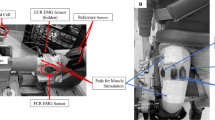Summary
The effect of electrode position on the upper trapezius muscle on the myo-electric signal amplitude was investigated with special reference to arm position and estimate of force output. Previously, a depression of the electromyogram (EMG) signal has been reported midway between the seventh cervical vertebrae (C7) and acromion (Veiersted 1991, Eur J Appl Physiol 62:91–98) although this electrode position has been recommended (Zipp 1982, Eur J Appl Physiol 50:41–54). Ten healthy subjects performed maximal shoulder elevations with the arm in vertical, abducted and flexed positions and they performed a dynamic movement test. The myo-electric signal was recorded along the length of the right upper trapezius muscle by a 16-channel bipolar array electrode and was integrated with a 0.2-s time resolution. A region just lateral to the midpoint between C7 and the lateral edge of acromion was found with high and stable amplitudes (% coefficient of variation equalled 5.6). At the midpoint a dip in the amplitude profile appeared which was slightly displaced by arm abduction or flexion probably due to sliding, of the skin relative to the muscle. A linear EMG-force relationship was found in the region with high signal amplitudes, whereas the more lateral and the dip region showed highly variable EMG-force relationships. Thus, it was found that when using bipolar surface electrodes with an interelectrode distance of 2 cm a centre position 2 cm lateral to the midpoint between C7 and acromion provided good repeatability and high signal yield.
Similar content being viewed by others
References
Basmajian JV, De Luca CJ (1985) Muscles alive. Williams and Wilkins, Baltimore
Bjelle A, Hagberg M, Michaelsson G (1981) Occupational and individual factors in acute shoulder-neck disorders among industrial workers. Br J Ind Med 38:356–363
Chaffin DB, Lee M, Freivalds A (1980) Muscle strength assessment from EMG analysis. Med Sci Sports Exerc 12:205–211
Christensen H (1986) Muscle activity and fatigue in the shoulder muscles of assembly plant employees. Scand J Work Environ Health 12:582–587
Hagberg C, Hagberg M (1989) Surface EMG amplitude and frequency dependence on exerted force for the upper trapezius muscle: a comparison between right and left sides. Eur J Appl Physiol 58:641–645
Jensen B (1992) Isometric contractions of small muscle groups. (PhD-thesis) Natl Inst Occup Health and Univ of Copenhagen, Copenhagen
Jensen C, Nilsen K, Hansen K, Westgaard RH (1993) Trapezius muscle load as a risk indicator for occupational shoulder-neck complaints. Int Arch Occup Environ Health 64:415–423
Jonsson B (1982) Measurement and evaluation of local muscular strain in the shoulder during constrained work. J Hum Ergol 11:73–88
Lawrence JH, De Luca CJ (1983) Myoelectric signal versus force relationship in different human muscles. J Appl Physiol 54:1653–1659
Mathiassen SE, Winkel J (1990) EMG-glenohumeral torque activity in the shoulder-neck region according to arm position and external load. Eur J Appl Physiol 61:370–379
Schüldt K, Ekholm J, Harms-Ringdahl K, Arborelius UP, Nemeth G (1987) Influence of sitting postures on neck and shoulder e.m.g. during arm-hand work movements. Clin Biomech 2:126–139
Veiersted KB (1991) The reproducibility of test contractions for calibration of electromyographic measurements. Eur J Appl Physiol 62:91–98
Veiersted KB, Westgaard RH, Andersen P (1990) Pattern of muscle activity during stereotyped work and its relation to muscle pain. Int Arch Occup Environ Health 62:31–41
Vigreux B, Cnockaert JC, Pertuzon E (1979) Factors influencing quantified surface EMGs. Eur J Appl Physiol 41:119–129
Westgaard RH (1988) Measurement and evaluation of postural load in occupational work situations. Eur J Appl Physiol 57:291–304
Westgaard RH, Bjørklund R (1987) Generation of muscle tension additional to postural muscle load. Ergonomics 30:911–923
Zipp P (1982) Recommendations for the standardization of lead positions in surface electromyography. Eur J Appl Physiol 50:41–54
Zuniga N, Truong XT, Simons DG (1970) Effects of skin electrode position on averaged electromyographic potentials. Arch Phys Med Rehabil 51:264–272
Author information
Authors and Affiliations
Rights and permissions
About this article
Cite this article
Jensen, C., Vasseljen, O. & Westgaard, R.H. The influence of electrode position on bipolar surface electromyogram recordings of the upper trapezius muscle. Europ. J. Appl. Physiol. 67, 266–273 (1993). https://doi.org/10.1007/BF00864227
Accepted:
Issue Date:
DOI: https://doi.org/10.1007/BF00864227




